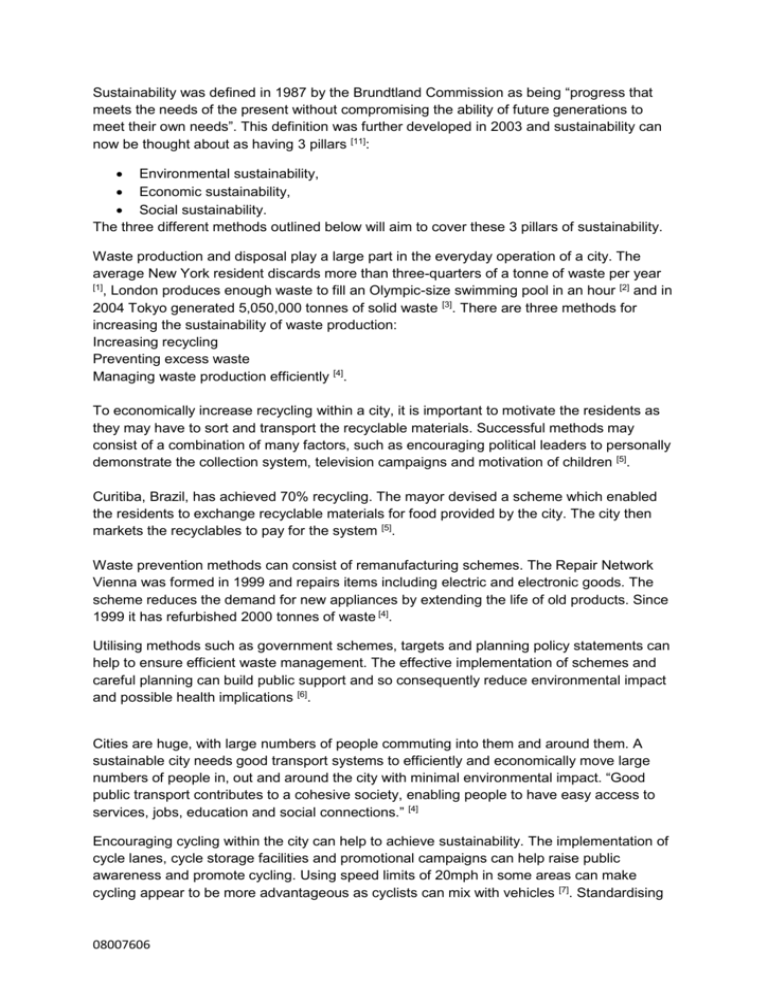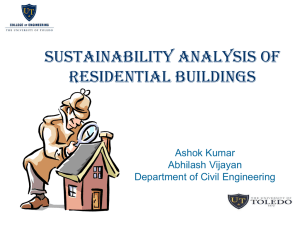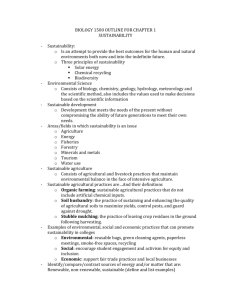Jo Miles – Sustainable Cities
advertisement

Sustainability was defined in 1987 by the Brundtland Commission as being “progress that meets the needs of the present without compromising the ability of future generations to meet their own needs”. This definition was further developed in 2003 and sustainability can now be thought about as having 3 pillars [11]: Environmental sustainability, Economic sustainability, Social sustainability. The three different methods outlined below will aim to cover these 3 pillars of sustainability. Waste production and disposal play a large part in the everyday operation of a city. The average New York resident discards more than three-quarters of a tonne of waste per year [1] , London produces enough waste to fill an Olympic-size swimming pool in an hour [2] and in 2004 Tokyo generated 5,050,000 tonnes of solid waste [3]. There are three methods for increasing the sustainability of waste production: Increasing recycling Preventing excess waste Managing waste production efficiently [4]. To economically increase recycling within a city, it is important to motivate the residents as they may have to sort and transport the recyclable materials. Successful methods may consist of a combination of many factors, such as encouraging political leaders to personally demonstrate the collection system, television campaigns and motivation of children [5]. Curitiba, Brazil, has achieved 70% recycling. The mayor devised a scheme which enabled the residents to exchange recyclable materials for food provided by the city. The city then markets the recyclables to pay for the system [5]. Waste prevention methods can consist of remanufacturing schemes. The Repair Network Vienna was formed in 1999 and repairs items including electric and electronic goods. The scheme reduces the demand for new appliances by extending the life of old products. Since 1999 it has refurbished 2000 tonnes of waste [4]. Utilising methods such as government schemes, targets and planning policy statements can help to ensure efficient waste management. The effective implementation of schemes and careful planning can build public support and so consequently reduce environmental impact and possible health implications [6]. Cities are huge, with large numbers of people commuting into them and around them. A sustainable city needs good transport systems to efficiently and economically move large numbers of people in, out and around the city with minimal environmental impact. “Good public transport contributes to a cohesive society, enabling people to have easy access to services, jobs, education and social connections.” [4] Encouraging cycling within the city can help to achieve sustainability. The implementation of cycle lanes, cycle storage facilities and promotional campaigns can help raise public awareness and promote cycling. Using speed limits of 20mph in some areas can make cycling appear to be more advantageous as cyclists can mix with vehicles [7]. Standardising 08007606 cycle networks and extending them across local authority boundaries may make cycling easier, quicker and safer. Removing selected parking sites can also encourage people to cycle instead of drive [7]. As petrol, diesel and oil prices rise, car drivers may have more incentive to change their commuting habits especially if they see specific provision has been made to help meet cyclists needs. Cities need large scale sustainable transport systems that are sustainable and easy to implement. What could be more sustainable and economical than good old fashioned pedal power? With 80% of Europe’s population living in urban areas and half the world’s population now living in urban settlements [4] social sustainability is an important component of a sustainable city. Ensuring that the residents have good housing, a high quality of life and secure jobs all contribute to the inhabitants satisfaction and the social sustainability of a city. Encouraging sustainable architecture and design can help to achieve sustainability. Using long-life durable materials will increase sustainability by reducing the need for rebuilding and repair [7]. Designing buildings that can accommodate varying lifestyles and changing user demands enables buildings to have a longer lifespan and ensures they are able to provide a long term investment. This reduces demolition and also enables people to live in the same building for longer periods of time [7]. Fitting new and existing buildings with renewable energy systems such as wind turbines, solar water heating and ground heat pumps will also help to increase sustainability and reduce the use of fossil fuels and non-renewable energies within the home and business [10]. Incorporating passive energy design into new builds will also increase long term sustainability. For example using natural ventilation to reduce the need for air conditioning, having large south facing windows to allow the maximum amount of light to increase warmth in the winter and reduce the need for electric lighting and having cavity walls to enable cavity wall insulation to be fitted [8] [9] [10]. The development of Energy Performance Certificates and Home Condition Reports which inform prospective tenants, purchasers and investors on the energy efficiency of the building [10] . This may help motivate more agents, architects and home owners to make their building more energy efficient and sustainable. A sustainable city is a long term ambition that will need a combination of many different approaches to ensure its success. However the method that may have the most impact on the majority of cities today is improving building sustainability. Many buildings throughout cities in the UK were destroyed during the war. When they were rebuilt in the late 20th century the sustainable ideas and technologies available then were not as developed as those available today. This has resulted in many unsustainable and poorly designed buildings standing and even deteriorating in our cities. 08007606 The implementation of this method would result in these buildings being demolished and redeveloped into more sustainable designs. However care should be taken to ensure new developments are in keeping with the character of the city. This scheme would have to be implemented in stages and only when a building had completely reached the end of its useable life should it be demolished. Many cities have already built sustainable buildings within them, for example the Bahrain World Trade Centre in Bahrain [12], The Gherkin Building in London [13] and the Atlantis Building in London [14]. However to have a greater impact sustainable design should be brought to residential buildings too. A different approach is not to develop sustainable buildings from scratch but to modify the existing ones. Changes such as incorporating renewable energies can be done without rebuilding. If the changes were restricted to the inside would the impact still be sufficiently sustainable? 08007606








